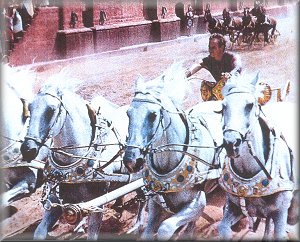
Chariot Racing: the F1 of Rome

Chariot racing was one of the least lethal of Roman forms of entertainment. It is also one of the sports that has remained almost unchanged in its concept, even in the modern period. Chariot racing was popular throughout the ancient world. The Roman form of racing was called "Currus". The Romans had three types of racing chariots, the "biga" drawn by two horses, the "triga" drawn by three horses and the "quadriga" drawn by four horses.
Chariot racing was one of the most popular past-times for gambling. The sport survives in the southwestern United States of America in the form of "Quarter horse racing", where a jockey is drawn is drawn behind horses running at a canter in a small chariot-like buggy. The speed of the horses is carefully controlled and is much less dangerous than the ancient form of chariot racing.
As many people in ancient Rome were unemployed they had lots of spare time on their hands. It was this very reason that the Roman emperors staged the games in order to distract the people from their hopeless poverty. The chariot racing was an ideal form of entertainment to distract the people as a "day at the races" provided fast-food (usually free), the opportunity to gamble and a carnival atmosphere- not forgetting the setting itself, the Circus Maximus of Rome which could seat up to 150 000 people.
There were usually four teams acing at any one time, the Blues, Greens, Reds and Whites. Support for these teams was intense which sometimes led to crowd disturbances and even violence. One rebellion against the empire began during one of these outbursts of hooliganism.
The races themselves were usually run over a five-mile distance, or seven laps of the track. There were frequent crashes, injuries and deaths as the charioteers thundered around the track and converged together at both ends of the "spina" (the central barrier that ran almost the full length of the track).
Unlike modern forms of horse racing, rider-less chariots could still win if they managed to finish ahead of their manned competitors. The sport does share some similarities with modern racing in the sense that successful horses would be used for breeding purposes. The successful charioteers could end up with enough wealth to buy their freedom, which even gladiators could do if they managed to survive long enough.
Gladiators and charioteers inhabited a special kind of celebrity status. They were almost universally respected, admired and sometimes even worshipped (their sweat was a highly prized aphrodisiac!), but at the same time they were reviled for being slaves and the "lowest of the low".
There is nothing new about the sport of racing horses. The sport itself even pre-dates the Roman empire- as far back as the first millennium BC. The addition of chariots begins with the foundation of the Roman Republic in 753BC and enjoyed popularity until the eventual collapse of the Roman Empire in 476AD. After the collapse of the Roman Empire the sport of horse racing and the science of breeding racehorses went into decline.
It wasn't until the twelfth century that horse racing began to reappear in England during the reign of the first Plantagenet king, Henry II, taking the form of simple wagers between members of the nobility and the royal family, hence the quote, "the sport of kings".
Horse racing itself remains one of the most popular sports in most countries around the world today particularly in western Europe, the USA, Australia and the Far and Middle East. It is one of the most highly organised and commercial of sports and like its ancient cousin- chariot racing still manages to delight and entertain race-goers.
Tasks:
1) What was the Roman form of chariot racing known as?
2) What were the different classes of chariots?
3) In what ways is the Quarter horse racing of the United States similar to chariot racing?
4) Why was chariot racing such a popular gambling sport?
5) What could a person enjoy at a day at the races?
6) Over what distance were the races run?
7) What dangers existed for the charioteers on the track?
8) What might eventually happen to a successful charioteer and gladiator?
9) How else were these sportsmen exploited?
10) How old is the idea of racing horses?
11) What happened to sport of racing after the collapse of the Roman Empire?
12) When did horse racing start to reappear in England?
13) Why do you think horse racing remains popular throughout the world?
14) What characteristics does chariot racing share with:
15) What could successful charioteers and gladiators eventually do?